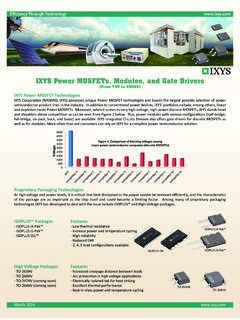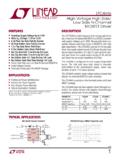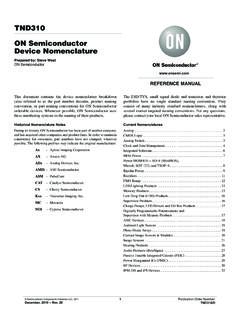Transcription of www.IGBT-Driver.com IGBT DRIVERS 27 ... - power …
1 Advantages of advanced ActiveClampingPower semiconductor manufacturers are offering IGBT modules with ever greater power densities. The limit is represented by the maximum power loss that can be dissipated; optimisation criteria are thepackaging technology as well as the conduction and switching losses of the semiconductor chips. The highcurrent density of the modules together with high switching speeds place increased demands on the driving circuits, both in normal switching operation and under overload conditions. advanced ActiveClamping switching technology offers a solution showing how modern high- power IGBTs can be betterutilised. Heinz R edi, Jan Thalheim and Olivier Garcia, CT-Concept Technologie AG, SwitzerlandParasitic inductances in IGBT modulesand converter circuits cannot becompletely eliminated for physical reasons,and their influence on the systembehaviour cannot be neglected. Figure 1(upper part) shows the parasiticinductances contained in a commutationcircuit.
2 The current change caused byturning off the IGBT produces voltagetransients at its collector, as shown in thelower part of Figure commutation speed and thus, theturn-off over-voltage at an IGBT can, inprinciple, be affected by the turn-off gateresistance Rg(off). This technique is usedparticularly at lower powers. However, Rg(off)must then be dimensioned for overloadconditions such as turn-off of the doublerated current, short circuit and a temporarilyincreased link circuit voltage. In normaloperation, this results in increasedswitching losses and turn-off delays, whichreduces the usability of the modules. Sothis simple method is unsuitable formodern high- power Turn-OffThe problems described above have ledto the development of two-stage turn-off,soft-switch-off, and slow turn-off drivercircuits operating with a reversible gateresistance. In normal operation, a low-ohmic gate resistor is used to turn the IGBToff in order to minimise the switchinglosses, and a high-ohmic one is used whena short circuit or surge current is detected(see Figure 2).
3 However, the problem lies in the reliabledetection of these conditions: desaturationmonitoring always involves a delay knownas the response time, usually of 4-10 s,until a fault is detected. When the IGBT sare driven with a pulse that is shorter thanthe response time in the event of a shortcircuit, the fault is not detected and thedriver turns off too quickly. The IGBT is thendestroyed by the resulting over-voltage. Moreover, coverage of limit cases(between over-current/non-over-current)presents a problem; for instance a higherover-voltage may well occur when thedouble rated current is turned off than at ashort-circuit kinds of driver circuits must beregarded as dangerous and users must beadvised against their use in equipment ofhigher power and in systems from whichhigh reliability is from that, a soft turn-off circuitdesigned for only two operating conditions isclearly unable to ensure optimal driving at alltimes under changing operating , this principle is, at best, acompromise, also with respect to ClampingSimple active clamping has alreadyFigure 1:Commutation circuitwith parasiticinductances (above)and typicalcharacteristic at IGBT turn-off (below) DRIVERS27 power Electronics EuropeIssue 8 2009been used for some time to protect powerMOSFETs.
4 active clamping means the directfeedback of the collector potential to thegate via an element with an avalanchecharacteristic. Figure 3 (upper part) showsthe principle on the basis of an feedback branch consists of aclamping element, as a rule comprising aseries of transient voltage suppressors(TVS). If the collector-emitter voltageexceeds the approximate breakdownvoltage of the clamping element, a currentflows via the feedback to the gate of theIGBT and raises its potential, so that therate of change of the collector current isreduced and a stable condition results. Thevoltage across the IGBT is then determinedby the design of the clamping element. TheIGBT operates in the active range of itsoutput characteristic and converts theenergy stored in the stray inductance intoheat. The clamping process continues untilthe stray inductances have beendemagnetised. The fundamentalrelationships involved here on the basis oftypical curves are illustrated in the lowerpart of Figure 3.
5 Benefits of active clamping : lSelf-adapting system, comes into action only when really neededlLower switching losseslSimple circuit configurationlThe IGBT to be protected is itself a major part of the protective circuitlNo additional power components (snubbers) requiredlRelatively exact voltage limitation independent of the operating point of the converterlConventional DRIVERS can be usedActive clamping offers more reliableprotection of the IGBTs than a soft turn-off circuit, does not require the detectionof a fault case, and offers active ClampingSimple active clamping is traditionallyused only to protect the semiconductor inthe event of overload. Consequently, theclamping elements are never subjected torecurrent pulse problem of repetitive operationtakes the following form: modern high- power IGBTs are optimally driven with gateresistors in the range from to severalohms. For turn-off, the driver supplies anoutput voltage of 10V.
6 However, theActive clamping Circuit must raise the gatevoltage temporarily to about +15V, in orderto reduce the rate of current change. Thisproduces a voltage drop of 25V across thegate resistor. A high current is absorbed bythe driver, which flows through the ActiveClamping circuit, where it produces highlosses and additional voltage drops. Thesimple active clamping circuit isconsequently unsuitable for repetitiveoperation. An improved active clamping circuit hasbeen presented with a plug-and-play driverfor IHM modules [1]. The circuit principle isshown in Figure 4. Here, the base of thechain of clamping diodes is, as usual,connected to the gate of the IGBT, butadditionally to the input of a booster driver voltage is consequently raised assoon as a current flows through theclamping element. The driver stage now nolonger draws any current from the clampingelement, and the current flowing throughthe latter is then available exclusively forcharging the gate.
7 The voltage drop andpower loss in the clamping diodes can thusbe dramatically reduced. This circuit hasproved its worth in the first generation ofSCALE plug-and-play DRIVERS used in a largenumber of industrial and Integrated advanced ActiveClampingThe SCALE-2 generation [2] offersAdvanced active clamping functionalitynot only in plug-and-play DRIVERS but alsoin driver cores. Figure 5 illustrates thiswith the circuit of the SCALE-2 2SC0435 Tlow-cost driver core with the use of theAdvanced active clamping base of the clamping elements is28 IGBT 8 2009 power Electronics EuropeFigure 3:Principle ofan IGBT driver withActive clamping (above) and typicalcharacteristic at turn-off with ActiveClamping (below)Figure 2:Principle ofan IGBT driver withsoft turn-offconnected not only to the gate of the IGBT,but also to the ACL input of the SCALE-2driver ASIC. The gate driver ASIC simplemented in sophisticated fast analogCMOS technology continuously raise theoutput resistance of the turn-off driverstage as the current to the ACL inputincreases.
8 When the current reachesseveral 100mA, the output stage has highimpedance, so that the driver no longerabsorbs any current from the clampingelement. This circuit operates moreefficiently than the discretely implementedsolution shown in Figure 4, usessignificantly fewer components and is verysimple and safe for the 6 shows the turn-off behaviourof the 2SP0320T plug-and-play driverwith an IGBT module FF450R12IE4 usingthe same SCALE-2 circuit technology withAdvanced active advanced active Clampingintegrated in the SCALE-2 chipset has inaddition to all the advantages of the simpleActive clamping solutions the followingbenefits:lSimple scalability in the voltage classlLow thermal load of the clamping elementslVery low-ohmic gate resistors possiblelSteep limiting characteristiclSuitable for all modern high- power IGBT moduleslPeriodic operation possiblelMinimum switching losseslImproved system performancelSelf-adapting system, acts only when really neededlCan be configured simply and safely lVery competitive system costsConclusionAdvanced active clamping is one of themost important features of a modern driverfor high- power IGBTs.
9 The circuit not onlyprotects the IGBT in the event of a fault, itis also the precondition for allowing theoptimal utilisation of IGBT modules withhigh power densities. Integration bysophisticated analog or mixed-signal ASIC technologies allows the simple and cost-effective implementation of AdvancedActive clamping with very few with advanced active Clampingare offered as ready adapted plug-and-playdrivers and in the form of driver cores. Thelatter allow the user to adapt the circuitry tohis benefits of advanced ActiveClamping for direct parallel connection ofIGBT modules, as well as in multileveltopologies, will be presented in the January2010 issue of PEE. The integration of dv/dtfeedback will also be [1] Heinz R edi, Peter K hli: SCALE Driver for High Voltage IGBTs, PCIME urope Conference ProceedingsNuremberg, 1999[2] Jan Thalheim, Heinz R edi:Universal Chipset for IGBT and power -MOSFET Gate DRIVERS , PCIM EuropeConference Proceedings Nuremberg, DRIVERS29 power Electronics EuropeIssue 8 2009 Figure 4:Principle of an IGBT driver with advanced active ClampingFigure 6:Switching behaviour of a FF450R12IE4 IGBT with the 2SP0320T (with advanced ActiveClamping) at Vdc= 800V and Ic= 900A, Lstray= 68nH, Temp = +25 CFigure 5:SCALE-2 Integration of advanced active clamping illustrated by the 2SC0435T driver cor






